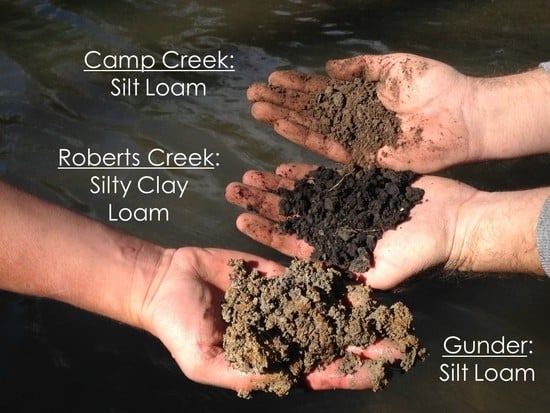Streambank Alluvial Unit Contributions to Suspended Sediment and Total Phosphorus Loads, Walnut Creek, Iowa, USA
Abstract
:1. Introduction
2. Materials and Methods
2.1. Watershed Description
2.2. Streambank Alluvial Units
2.3. Eroding Streambank Length Survey and Streambank Plot Selection
2.4. Streambank Plot Design and Measurement Protocol
2.5. Streambank Soil Sample Extraction and Analyses
2.6. Quantification of Streambank Alluvial Unit Surface Area
2.7. Quantification of Sediment and TP Mass Contribution
2.7.1. Calculation of Mass Contribution
2.7.2. Assigning Units to Individual Pin Readings
2.7.3. Negative Pin Readings
2.8. Correlation with Discharge
2.9. Statistical Methods
3. Results
3.1. Precipitation, Hydrology, and Streambank Eroding Length
3.2. Alluvial Unit Total Phosphorus Concentration and Soil Parameters
3.3. Alluvial Unit Surface Area Representation within Eroding Streambank Faces
3.4. Streambank Recession
3.4.1. Daily Erosion Rate
3.4.2. Cumulative Recession
3.5. Streambank Sediment and TP Mass Loss
3.5.1. Cumulative Sediment Mass
3.5.2. Cumulative TP Mass
3.6. Impact of Flow on Recession
4. Discussion
4.1. Streambank Suface Area
4.2. Streambank Material Recession and Streamflow Impacts
4.3. Sediment and TP Mass Losses
5. Conclusions
6. Patents
Acknowledgments
Author Contributions
Conflicts of Interest
References
- EPA National Summary of Impaired Waters and TMDL Information|Water Quality Assessment and TMDL Information|US EPA. Available online: https://iaspub.epa.gov/waters10/attains_nation_cy.control?p_report_type=T (accessed on 12 January 2018).
- Smith, V.H. Eutrophication of freshwater and coastal marine ecosystems a global problem. Environ. Sci. Pollut. Res. 2003, 10, 126–139. [Google Scholar] [CrossRef]
- Daniel, T.C.; Sharpley, A.N.; Lemunyon, J.L. Agricultural Phosphorus and Eutrophication: A Symposium Overview. J. Environ. Qual. 1998, 27, 251. [Google Scholar] [CrossRef]
- Fox, G.A.; Purvis, R.A.; Penn, C.J. Streambanks: A net source of sediment and phosphorus to streams and rivers. J. Environ. Manag. 2016, 181, 602–614. [Google Scholar] [CrossRef] [PubMed]
- Hamlett, J.M.; Baker, J.L.; Johnson, H.P. Channel morphology changes and sediment yield for a small agricultural watershed in Iowa. Am. Soc. Agric. Eng. 1983, 26, 1390–1396. [Google Scholar] [CrossRef]
- Odgaard, A.J. Streambank erosion along two rivers in Iowa. Water Resour. Res. 1987, 23, 1225–1236. [Google Scholar] [CrossRef]
- Wilkin, D.C.; Hebel, S.J. Erosion, redeposition, and delivery of sediment to midwestern streams. Water Resour. Res. 1982, 18, 1278–1282. [Google Scholar] [CrossRef]
- Thoma, D.P.; Gupta, S.C.; Bauer, M.E.; Kirchoff, C.E. Airborne laser scanning for riverbank erosion assessment. Remote Sens. Environ. 2005, 95, 493–501. [Google Scholar] [CrossRef]
- Mukundan, R.; Radcliffe, D.E.; Ritchie, J.C.; Risse, L.M.; McKinley, R.A. Sediment Fingerprinting to Determine the Source of Suspended Sediment in a Southern Piedmont Stream. J. Environ. Qual. 2010, 39, 1328. [Google Scholar] [CrossRef] [PubMed]
- Wilson, C.G.; Kuhnle, R.A.; Bosch, D.D.; Steiner, J.L.; Starks, P.J.; Tomer, M.D.; Wilson, G.V. Quantifying relative contributions from sediment sources in Conservation Effects Assessment Project watersheds. J. Soil Water Conserv. 2008, 63, 523–532. [Google Scholar] [CrossRef]
- Belmont, P.; Gran, K.B.; Schottler, S.P.; Wilcock, P.R.; Day, S.S.; Jennings, C.; Lauer, J.W.; Viparelli, E.; Willenbring, J.K.; Engstrom, D.R.; et al. Large shift in source of fine sediment in the upper Mississippi River. Environ. Sci. Technol. 2011, 45, 8804–8810. [Google Scholar] [CrossRef] [PubMed]
- Willett, C.D.; Lerch, R.N.; Schultz, R.C.; Berges, S.A.; Peacher, R.D.; Isenhart, T.M. Streambank erosion in two watersheds of the Central Claypan Region of Missouri, United States. J. Soil Water Conserv. 2012, 67, 249–263. [Google Scholar] [CrossRef]
- Gellis, A.C.; Fuller, C.C.; Van Metre, P.C. Sources and ages of fine-grained sediment to streams using fallout radionuclides in the Midwestern United States. J. Environ. Manag. 2017, 194, 73–85. [Google Scholar] [CrossRef] [PubMed]
- Palmer, J.A.; Schilling, K.E.; Isenhart, T.M.; Schultz, R.C.; Tomer, M.D. Streambank erosion rates and loads within a single watershed: Bridging the gap between temporal and spatial scales. Geomorphology 2014, 209, 66–78. [Google Scholar] [CrossRef]
- Bull, L.J. Magnitude and variation in the contribution of bank erosion to the suspended sediment load of the River Severn, UK. Earth Surf. Process. Landf. 1997, 22, 1109–1123. [Google Scholar] [CrossRef]
- Walling, D.E.; Woodward, J.C. Tracing sources of suspended sediment in river basins: A case study of the River Culm, Devon, UK. Mar. Freshw. Res. 1995, 46, 327–336. [Google Scholar] [CrossRef]
- Russell, M.A.; Walling, D.E.; Hodgkinson, R. Suspended sediment sources in two small lowland agricultural catchments in the UK. J. Hydrol. 2001, 252, 1–24. [Google Scholar] [CrossRef]
- Kronvang, B.; Laubel, A.; Grant, R. Suspended sediment and particulate phosphorus transport and delivery pathways in an arable catchment, Gelbaek Stream, Denmark. Hydrol. Process. 1997, 11, 627–642. [Google Scholar] [CrossRef]
- Sekely, A.C.; Mulla, D.J.; Bauer, D.W. Streambank slumping and its contribution to the phosphorus and suspended sediment loads of the Blue Earth River, Minnesota. J. Soil Water Conserv. 2002, 57, 243–250. [Google Scholar] [CrossRef]
- Miller, R.B.; Fox, G.A.; Penn, C.J.; Wilson, S.; Parnell, A.; Purvis, R.A.; Criswell, K. Estimating sediment and phosphorus loads from streambanks with and without riparian protection. Agric. Ecosyst. Environ. 2014, 189, 70–81. [Google Scholar] [CrossRef]
- Walling, D.E.; Collins, A.L.; Stroud, R.W. Tracing suspended sediment and particulate phosphorus sources in catchments. J. Hydrol. 2008, 350, 274–289. [Google Scholar] [CrossRef]
- Iowa Department of Agriculture and Land Stewardship; Iowa Department of Natural Resources. ISU Iowa Nutrient Reduction Strategy; Iowa State University: Ames, IA, USA, 2014; Volume 27. [Google Scholar]
- Parker, C.; Simon, A.; Thorne, C.R. The effects of variability in bank material properties on riverbank stability: Goodwin Creek, Mississippi. Geomorphology 2008, 101, 533–543. [Google Scholar] [CrossRef]
- Kessler, A.C.; Gupta, S.C.; Brown, M.K. Assessment of river bank erosion in Southern Minnesota rivers post European settlement. Geomorphology 2013, 201, 312–322. [Google Scholar] [CrossRef]
- Daly, E.R.; Fox, G.A.; Al-Madhhachi, A.-S.T.; Storm, D.E. Variability of fluvial erodibility parameters for streambanks on a watershed scale. Geomorphology 2015, 231, 281–291. [Google Scholar] [CrossRef]
- Konsoer, K.M.; Rhoads, B.L.; Langendoen, E.J.; Best, J.L.; Ursic, M.E.; Abad, J.D.; Garcia, M.H. Spatial variability in bank resistance to erosion on a large meandering, mixed bedrock-alluvial river. Geomorphology 2016, 252, 80–97. [Google Scholar] [CrossRef]
- Schilling, K.E.; Palmer, J.A.; Bettis, E.A.; Jacobson, P.; Schultz, R.C.; Isenhart, T.M. Vertical distribution of total carbon, nitrogen and phosphorus in riparian soils of Walnut Creek, southern Iowa. Catena 2009, 77, 266–273. [Google Scholar] [CrossRef]
- Layzell, A.L.; Mandel, R.D. An assessment of the erodibility of Holocene lithounits comprising streambanks in northeastern Kansas, USA. Geomorphology 2014, 213, 116–127. [Google Scholar] [CrossRef]
- Hooke, J.M. An analysis of the processes of river bank erosion. J. Hydrol. 1979, 42, 39–62. [Google Scholar] [CrossRef]
- Wolman, M.G. Factors Influencing Erosion of a Cohesive River Bank. Am. J. Sci. 1959, 257, 204–216. [Google Scholar] [CrossRef]
- Hongthanat, N.; Kovar, J.L.; Thompson, M.L. Sorption indices to estimate risk of soil phosphorus loss in the Rathbun Lake watershed, Iowa. Soil Sci. 2011, 176, 237–244. [Google Scholar] [CrossRef]
- Lyons, N.J.; Starek, M.J.; Wegmann, K.W.; Mitasova, H. Bank erosion of legacy sediment at the transition from vertical to lateral stream incision. Earth Surf. Process. Landf. 2015, 40, 1764–1778. [Google Scholar] [CrossRef]
- Schenk, E.R.; Hupp, C.R. Legacy effects of colonial millponds on floodplain sedimentation, bank erosion, and channel morphology, MID-Atlantic, USA. J. Am. Water Resour. Assoc. 2009, 45, 597–606. [Google Scholar] [CrossRef]
- Starek, M.J.; Mitasova, H.; Wegmann, K.W.; Lyons, N. Space-time cube representation of stream bank evolution mapped by terrestrial laser scanning. IEEE Geosci. Remote Sens. Lett. 2013, 10, 1369–1373. [Google Scholar] [CrossRef]
- Donovan, M.; Miller, A.; Baker, M.; Gellis, A. Sediment contributions from floodplains and legacy sediments to Piedmont streams of Baltimore County, Maryland. Geomorphology 2015, 235, 88–105. [Google Scholar] [CrossRef]
- Harden, C.P.; Foster, W.; Morris, C.; Chartrand, K.J.; Henry, E. Rates and Processes of Streambank Erosion in Tributaries of the Little River, Tennessee. Phys. Geogr. 2009, 30, 1–16. [Google Scholar] [CrossRef]
- Laubel, A.; Kronvang, B.; Hald, A.B.; Jensen, C. Hydromorphological and biological factors influencing sediment and phosphorus loss via bank erosion in small lowland rural streams in Denmark. Hydrol. Process. 2003, 17, 3443–3463. [Google Scholar] [CrossRef]
- Veihe, A.; Jensen, N.H.; Schiøtz, I.G.; Nielsen, S.L. Magnitude and processes of bank erosion at a small stream in Denmark. Hydrol. Process. 2011, 25, 1597–1613. [Google Scholar] [CrossRef]
- Griffith, G.E.; Omernik, J.M.; Wilton, T.F.; Pierson, S.M. Ecoregions and Subregions of Iowa: A Framework for Water Quality Assessment and Management. J. Iowa Acad. Sci. JIAS 1994, 101, 5–13. [Google Scholar]
- Schilling, K.E.; Hubbard, T.; Luzier, J.; Spooner, J. Iowa Geological Survey Walnut Creek Watershed Restoration and Water Quality Monitoring Project: Final Report; Iowa Department of Natural Resources: Des Moines, IA, USA, 2006.
- Schilling, K.E.; Thompson, C.A. Walnut Creek Watershed Monitoring Project, Iowa Monitoring Water Quality in Response to Prairie Restoration. J. Am. Water Resour. Assoc. 2000, 36, 1101–1114. [Google Scholar] [CrossRef]
- Schilling, K.E.; Wolter, C.F. Application of GPS and GIS to Map Channel Features in Walnut Creek. Iowa J. Am. Water Resour. Assoc. 2000, 36, 1423–1434. [Google Scholar] [CrossRef]
- Schilling, K.E.; Isenhart, T.M.; Palmer, J.A.; Wolter, C.F.; Spooner, J. Impacts of Land-Cover Change on Suspended Sediment Transport in Two Agricultural Watersheds1. JAWRA J. Am. Water Resour. Assoc. 2011, 47, 672–686. [Google Scholar] [CrossRef]
- Simon, A. A model of channel response in disturbed alluvial channels. Earth Surf. Process. Landf. 1989, 14, 11–26. [Google Scholar] [CrossRef]
- Bettis, E.A. The Deforest Formation of Western Iowa: Lithologic Properties, Stratigraphy, and Chronology; Iowa Department of Natural Resources: Des Moines, IA, USA, 1990.
- Bettis, E.A.; Baker, R.G.; Green, W.R.; Whelan, M.K.; Benn, D.W. Late Wisconsin and Holocene Alluvial Stratigraphy, Paleoecology, and Archaeological Geology of East-Central Iowa: Guidebook Series No. 12; Iowa Department of Natural Resources: Des Moines, IA, USA, 1992; pp. 1–61.
- Bettis, E.A.; Autin, W.J. Complex response of a midcontinent North America drainage system to late Wisconsinan sedimentation. J. Sediment. Res. 1997, 67, 740–748. [Google Scholar]
- Baker, R.G.; Bettis, E.A.; Horton, D.G. Late Wisconsinan-early Holocene riparian paleoenvironment in southeastern. Iowa Geol. Soc. Am. Bull. 1993, 105, 206–212. [Google Scholar] [CrossRef]
- Baker, R.G.; Bettis, E.A.; Denniston, R.F.; Gonzalez, L.A.; Strickland, L.E.; Krieg, J.R. Holocene paleoenvironments in southeastern Minnesota—Chasing the prairie-forest ecotone. Palaeogeogr. Palaeoclimatol. Palaeoecol. 2002, 177, 103–122. [Google Scholar] [CrossRef]
- United States Department of Agriculture; Natural Resources Conservation Service. National Biology Handbook Subpart B—Conservation Planning: Part 614, Stream Visual Assessment Protocol Version 2; 190-NBH, Amend. 3, December, 2009; United States Department of Agriculture; Natural Resources Conservation Service: Washington, DC, USA, 2009.
- Zaimes, G.N.; Schultz, R.C.; Isenhart, T.M. Stream bank erosion adjacent to riparian forest buffers, row-crop fields, and continuously-grazed pastures along Bear Creek in central Iowa. J. Soil Water Conserv. 2004, 59, 19–27. [Google Scholar]
- Tufekcioglu, M.; Isenhart, T.M.; Schultz, R.C.; Bear, D.A.; Kovar, J.L.; Russell, J.R. Stream bank erosion as a source of sediment and phosphorus in grazed pastures of the Rathbun Lake Watershed in southern Iowa, United States. J. Soil Water Conserv. 2012, 67, 545–555. [Google Scholar] [CrossRef]
- Lawler, D.M. The measurement of river bank erosion and lateral channel change: A review. Earth Surf. Process. Landf. 1993, 18, 777–821. [Google Scholar] [CrossRef]
- Klute, A.; Gee, G.W.; Bauder, J.W. Particle-size Analysis. In Methods of Soil Analysis: Part 1—Physical and Mineralogical Methods; Soil Science Society of America-American Society of Agronomy: Madison, WI, USA, 1986; Volume 9, pp. 383–411. [Google Scholar]
- McGrath, S.P.; Cunliffe, C.H. A simplified method for the extraction of the metals Fe, Zn, Cu, Ni, Cd, Pb, Cr, Co and Mn from soils and sewage sludges. J. Sci. Food Agric. 1985, 36, 794–798. [Google Scholar] [CrossRef]
- Couper, P.; Stott, T.; Maddock, I. Insights into river bank erosion processes derived from analysis of negative erosion-pin recordings: Observations from three recent UK studies. Earth Surf. Process. Landforms 2002, 27, 59–79. [Google Scholar] [CrossRef]
- R Core Team. R: A Language and Environment for Statistical Computing; R Foundation for Statistical Computing: Vienna, Austria, 2017. [Google Scholar]
- Wynn, T.M.; Henderson, M.B.; Vaughan, D.H. Changes in streambank erodibility and critical shear stress due to subaerial processes along a headwater stream, southwestern Virginia, USA. Geomorphology 2008, 97, 260–273. [Google Scholar] [CrossRef]
- Couper, P.R.; Maddock, I.P. Subaerial river bank erosion processes and their interaction with other bank erosion mechanisms on the River Arrow, Warwickshire, UK. Earth Surf. Process. Landf. 2001, 26, 631–646. [Google Scholar] [CrossRef]
- Couper, P. Effects of silt-clay content on the susceptibility of river banks to subaerial erosion. Geomorphology 2003, 56, 95–108. [Google Scholar] [CrossRef]
- Bryan, R.B. Soil erodibility and processes of water erosion on hillslope. Geomorphology 2000, 32, 385–415. [Google Scholar] [CrossRef]
- Julian, J.P.; Torres, R. Hydraulic erosion of cohesive riverbanks. Geomorphology 2006, 76, 193–206. [Google Scholar] [CrossRef]
- Lawler, A.D.M. River bank erosion and the influence of frost : A statistical examination. Trans. Inst. Br. Geogr. 2016, 11, 227–242. [Google Scholar] [CrossRef]
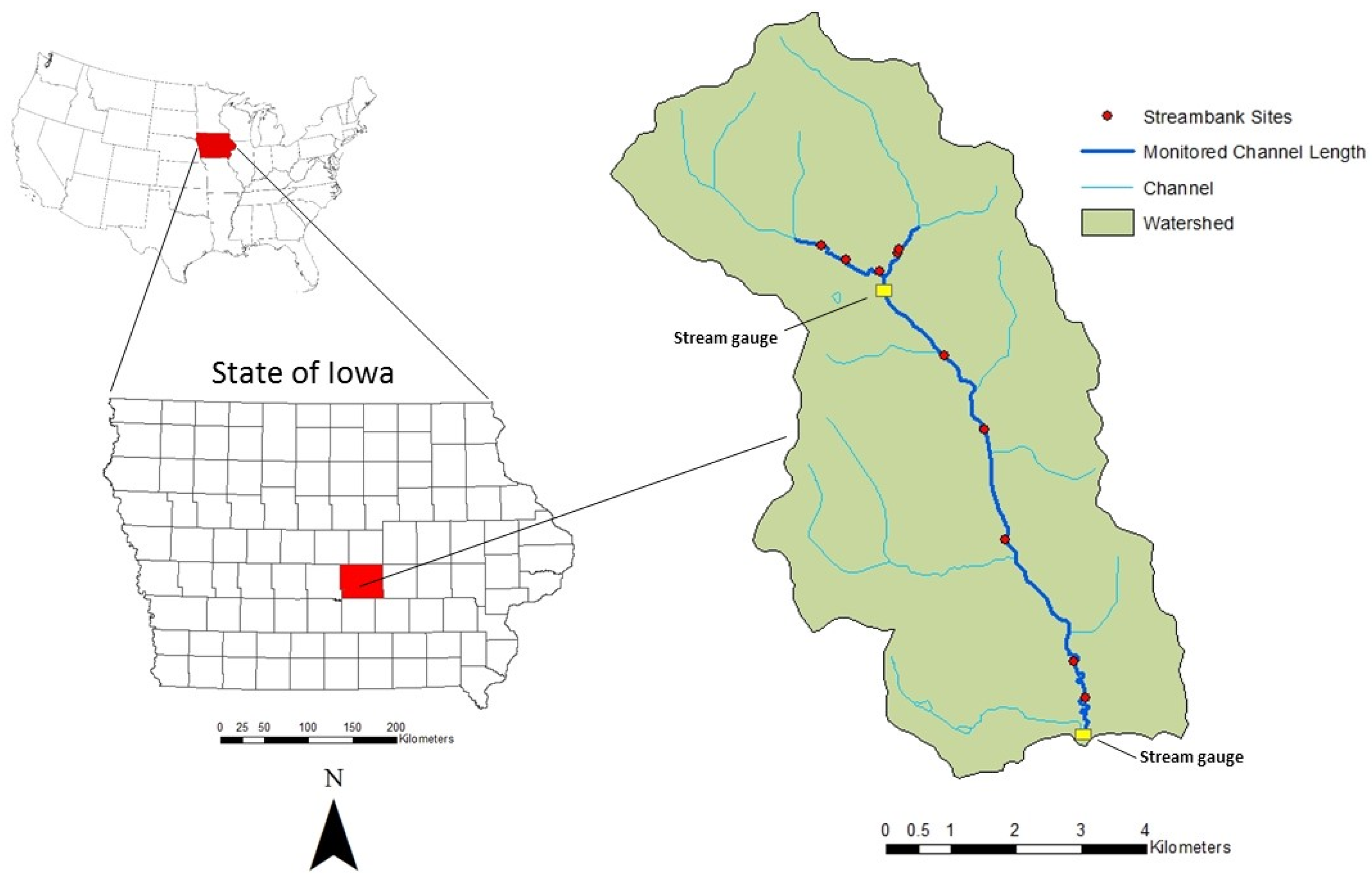
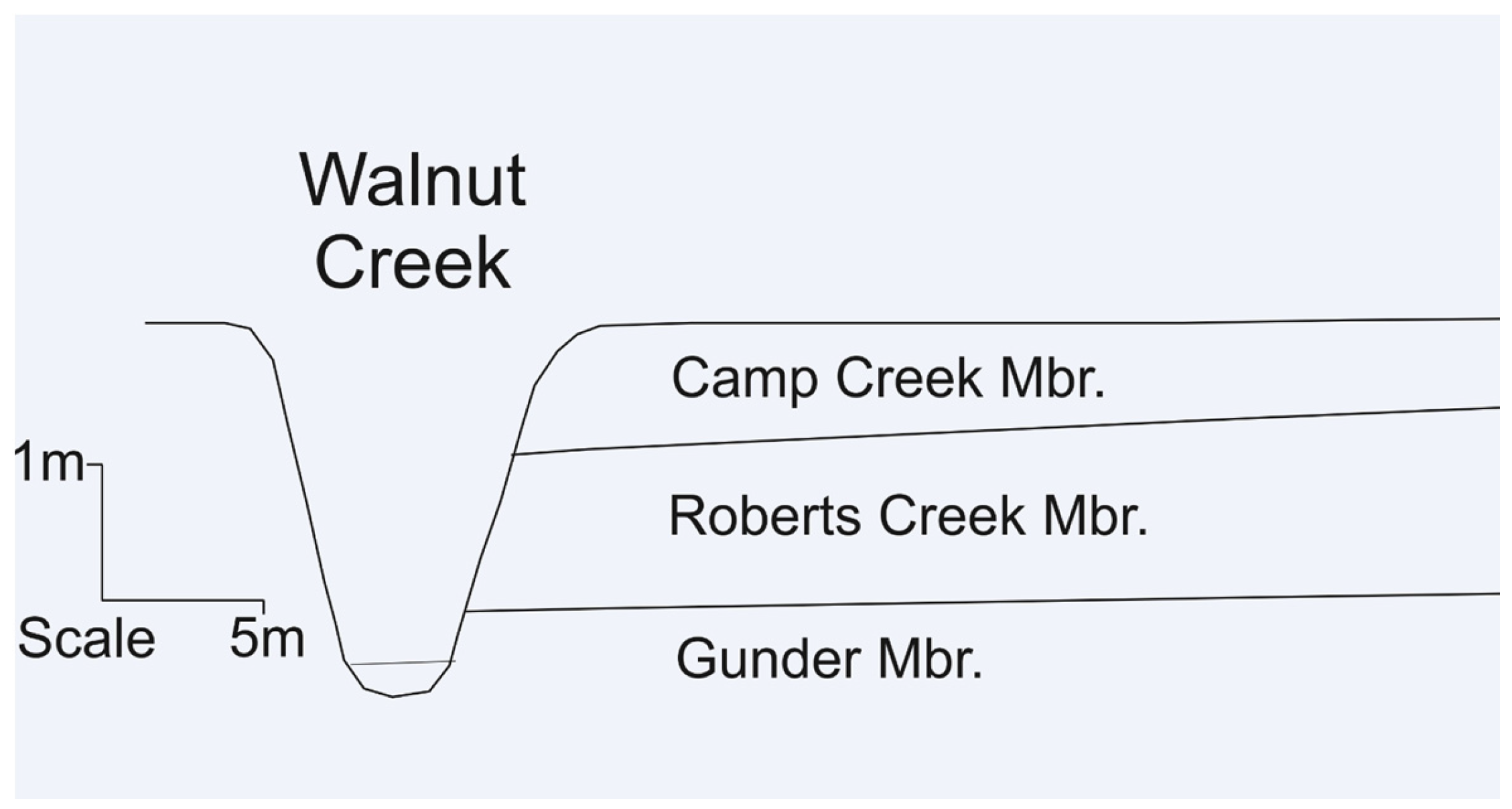
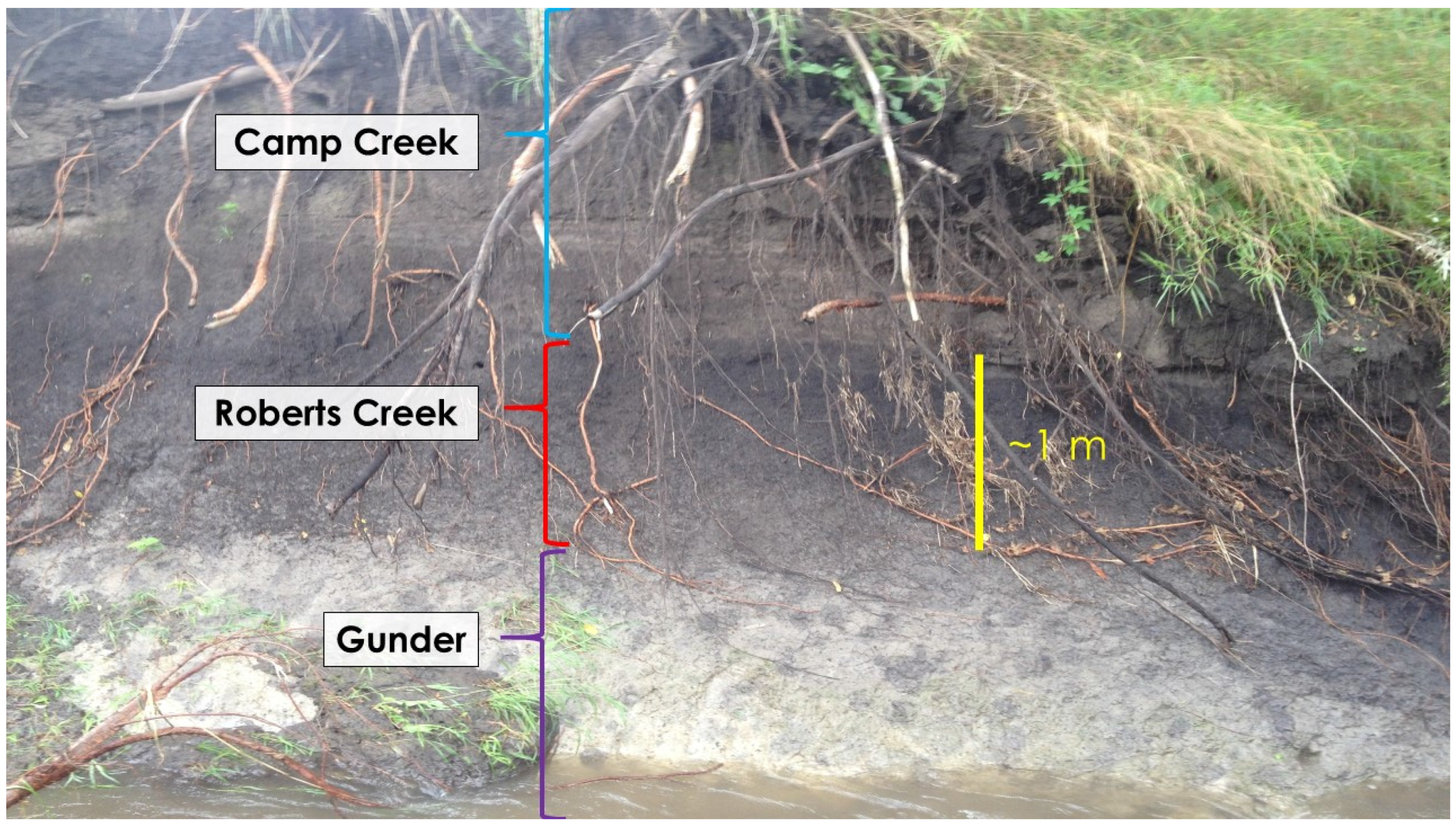

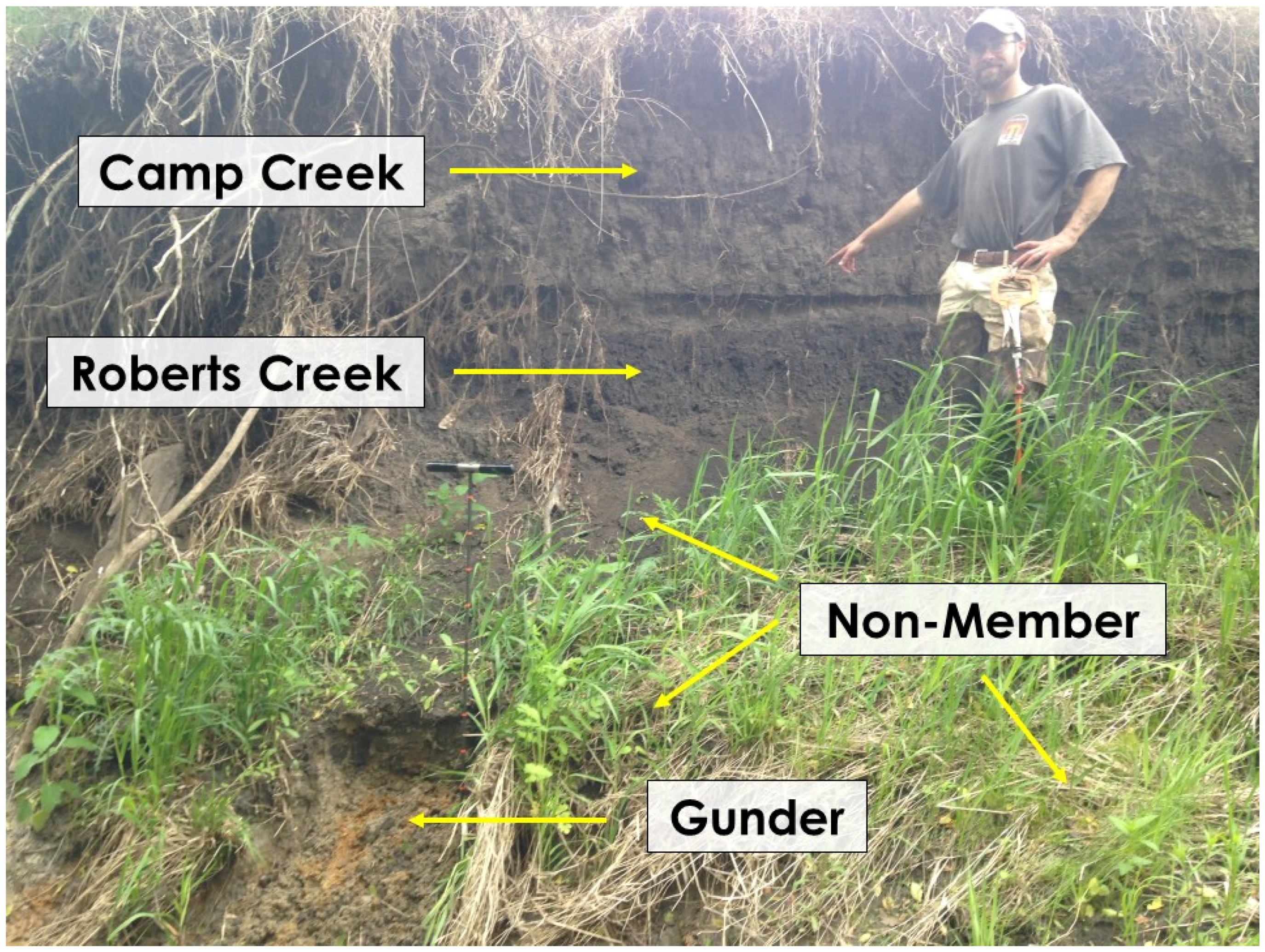
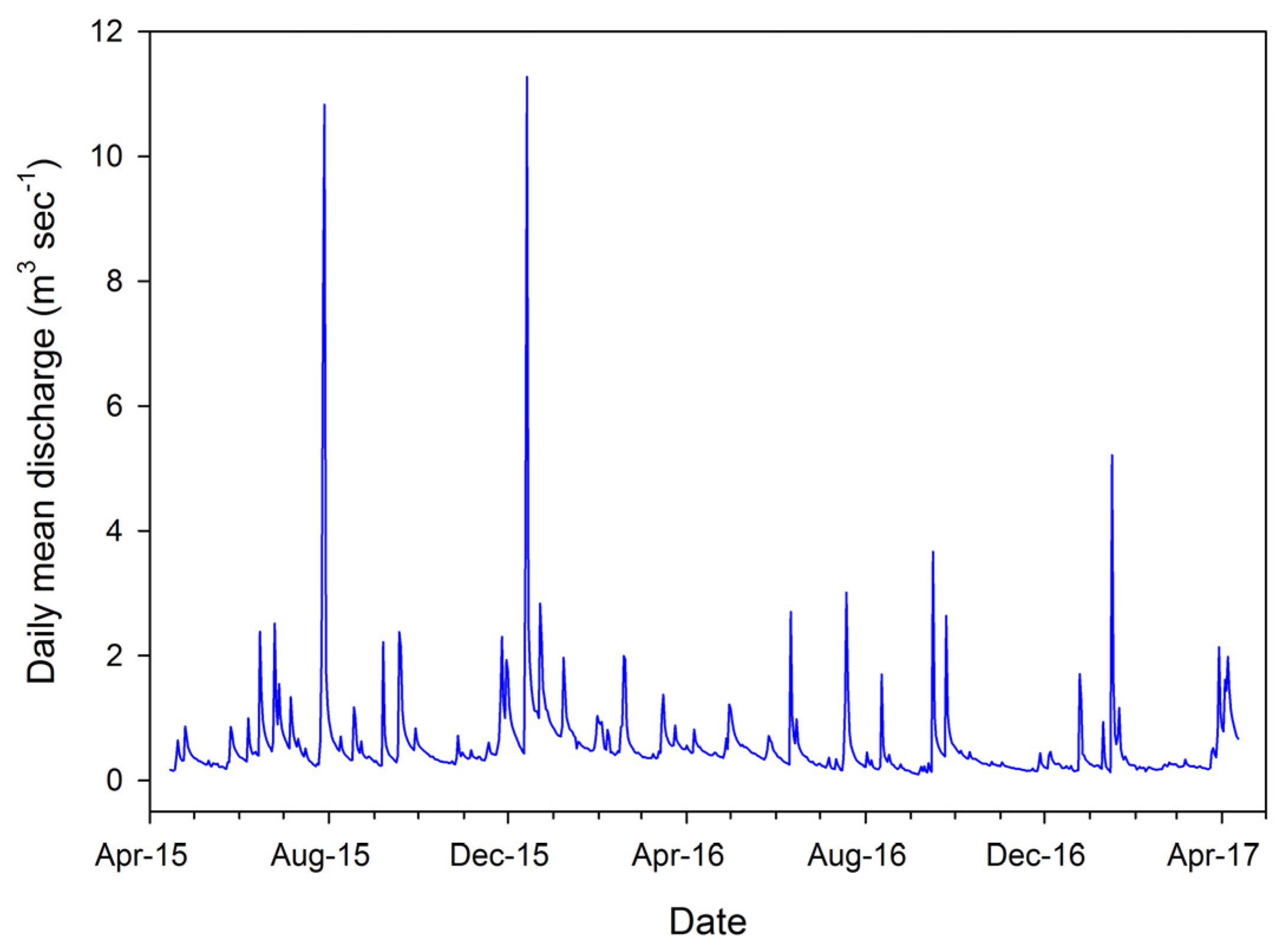
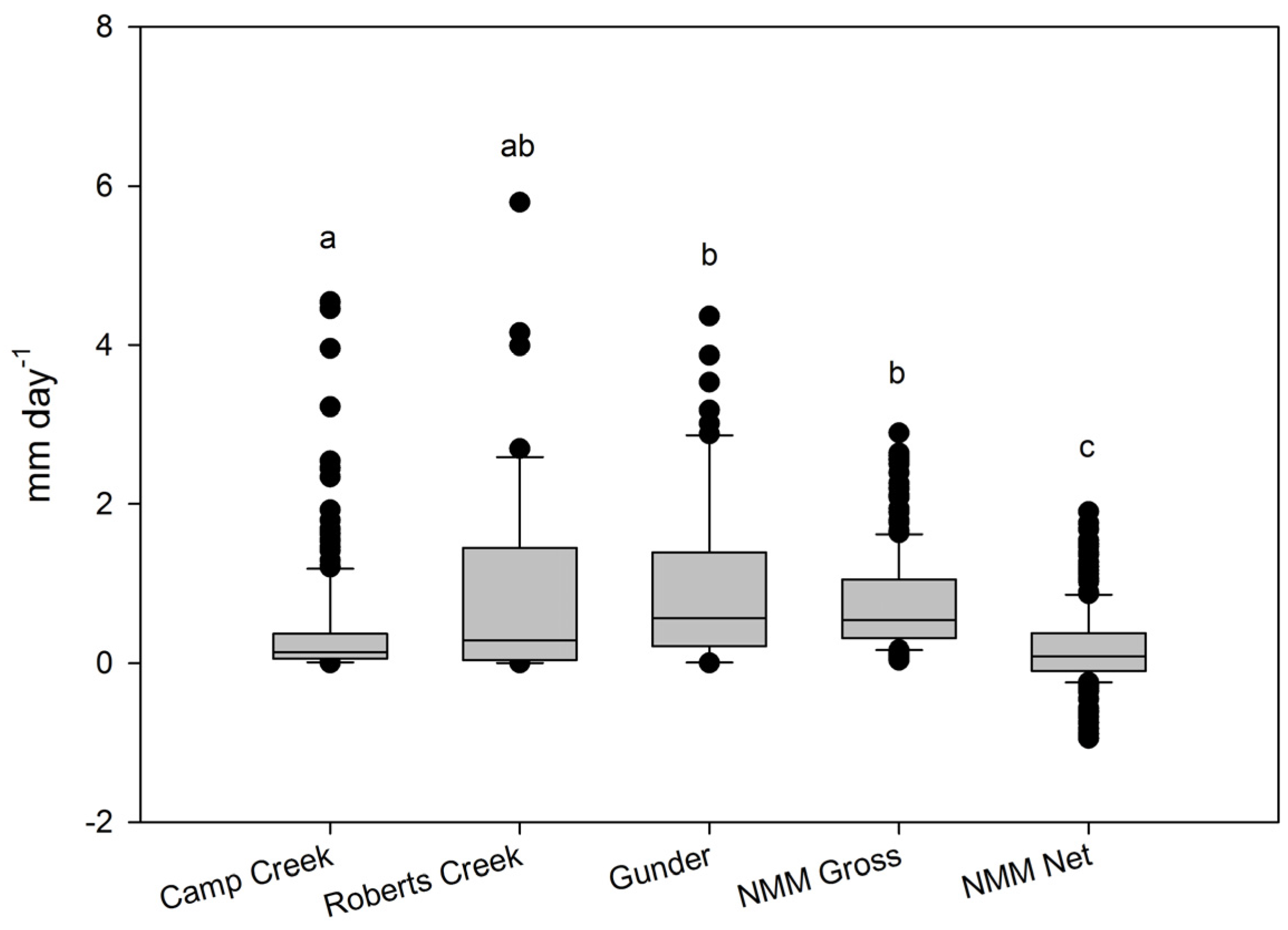
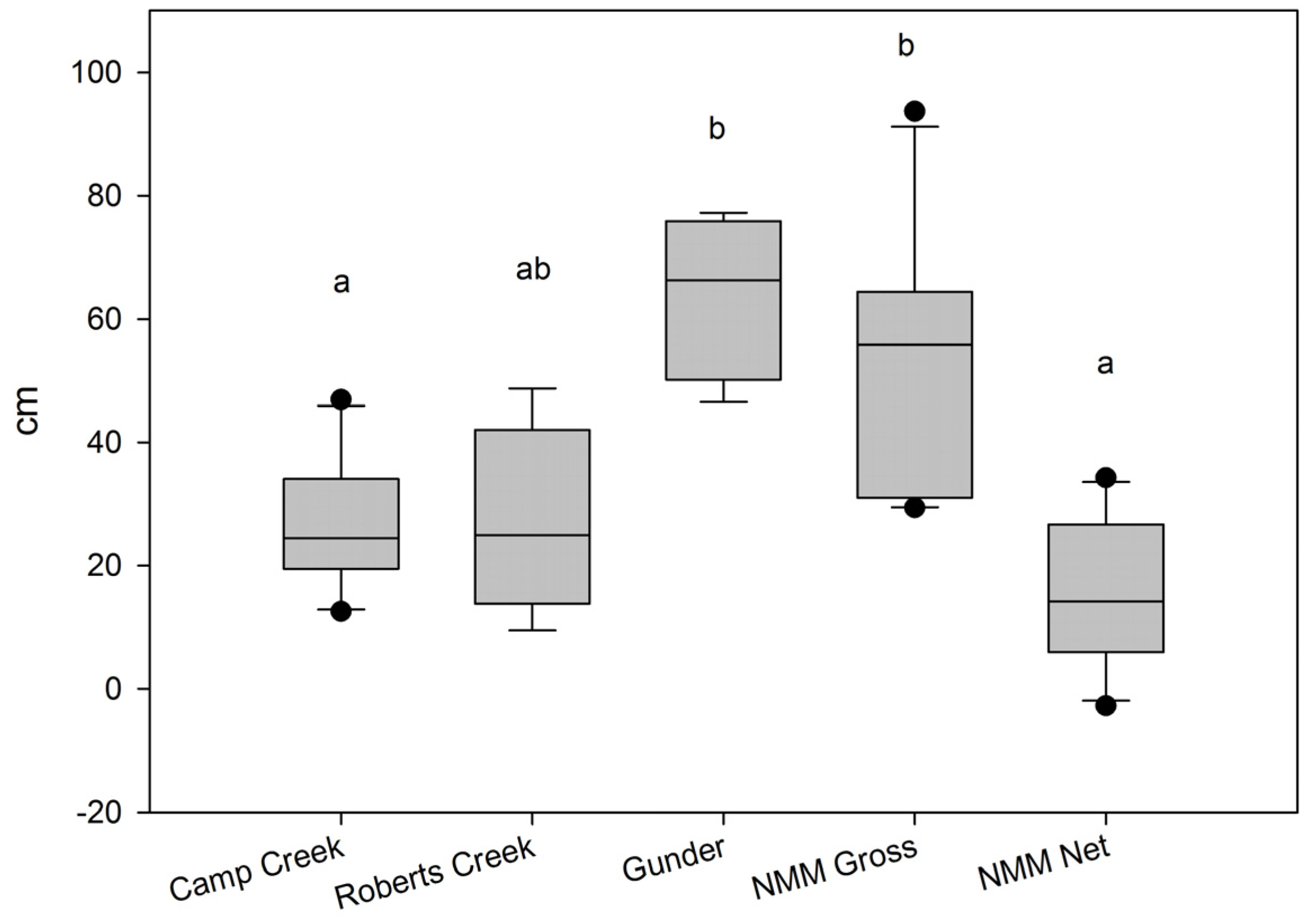

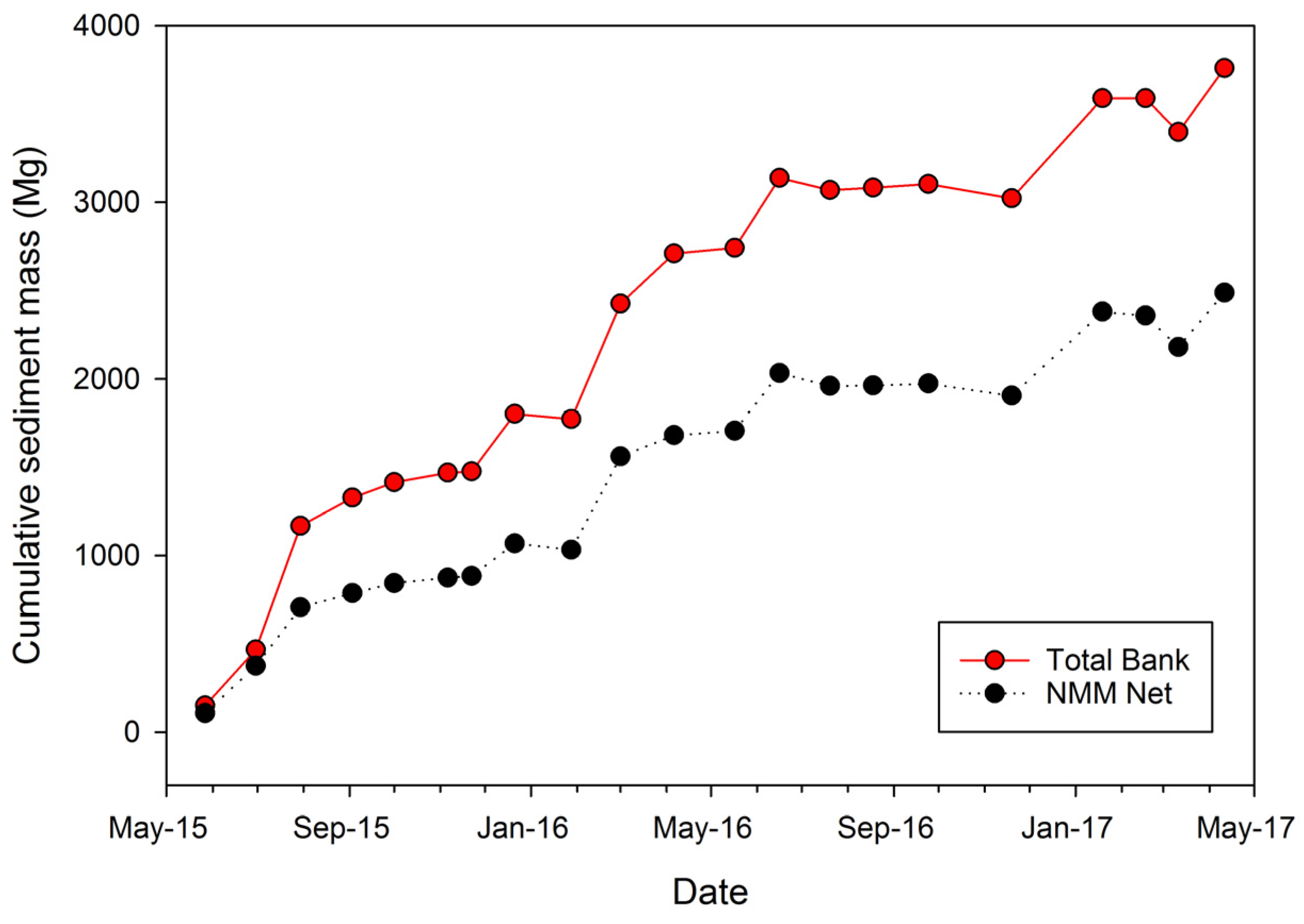
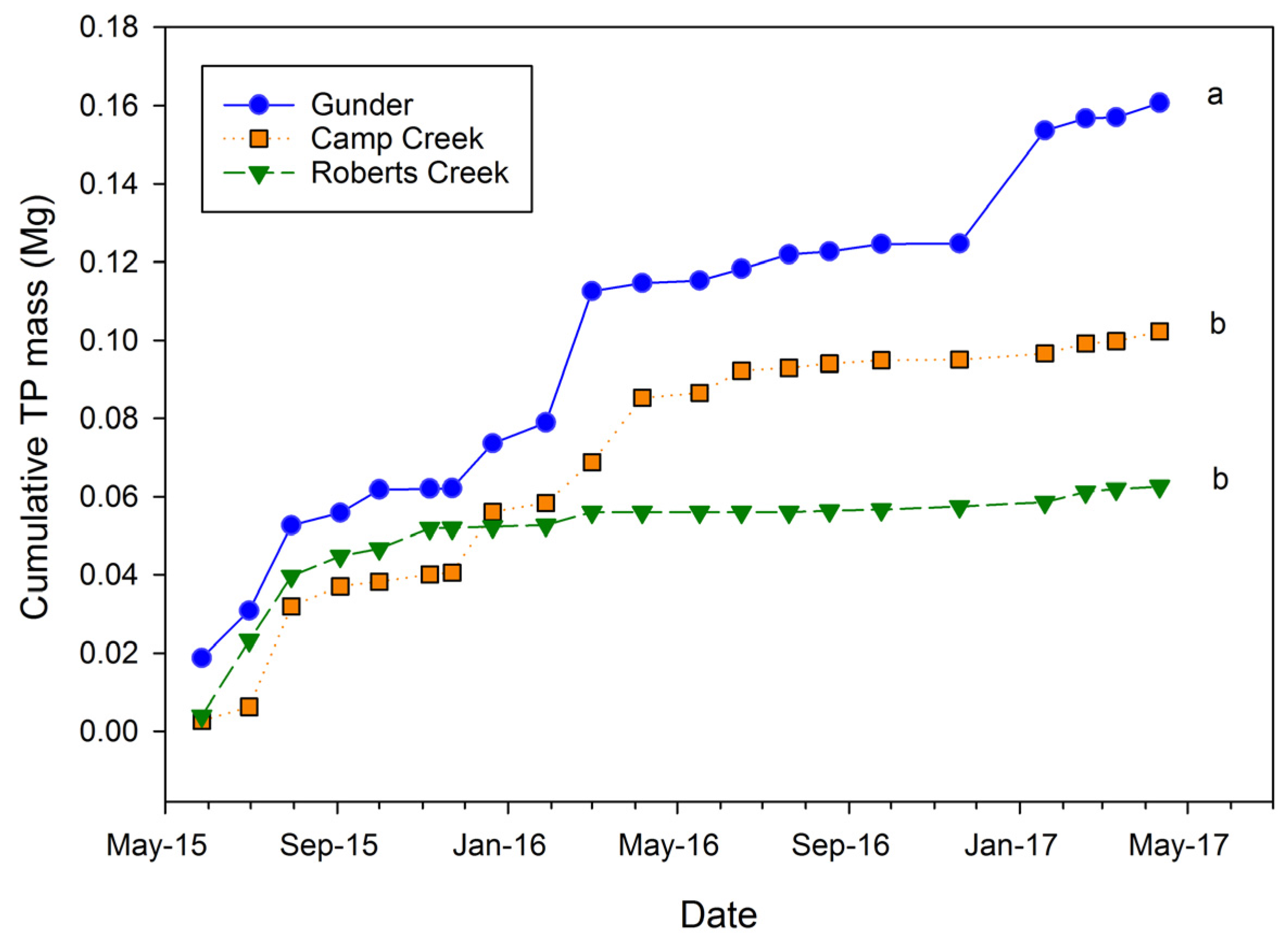
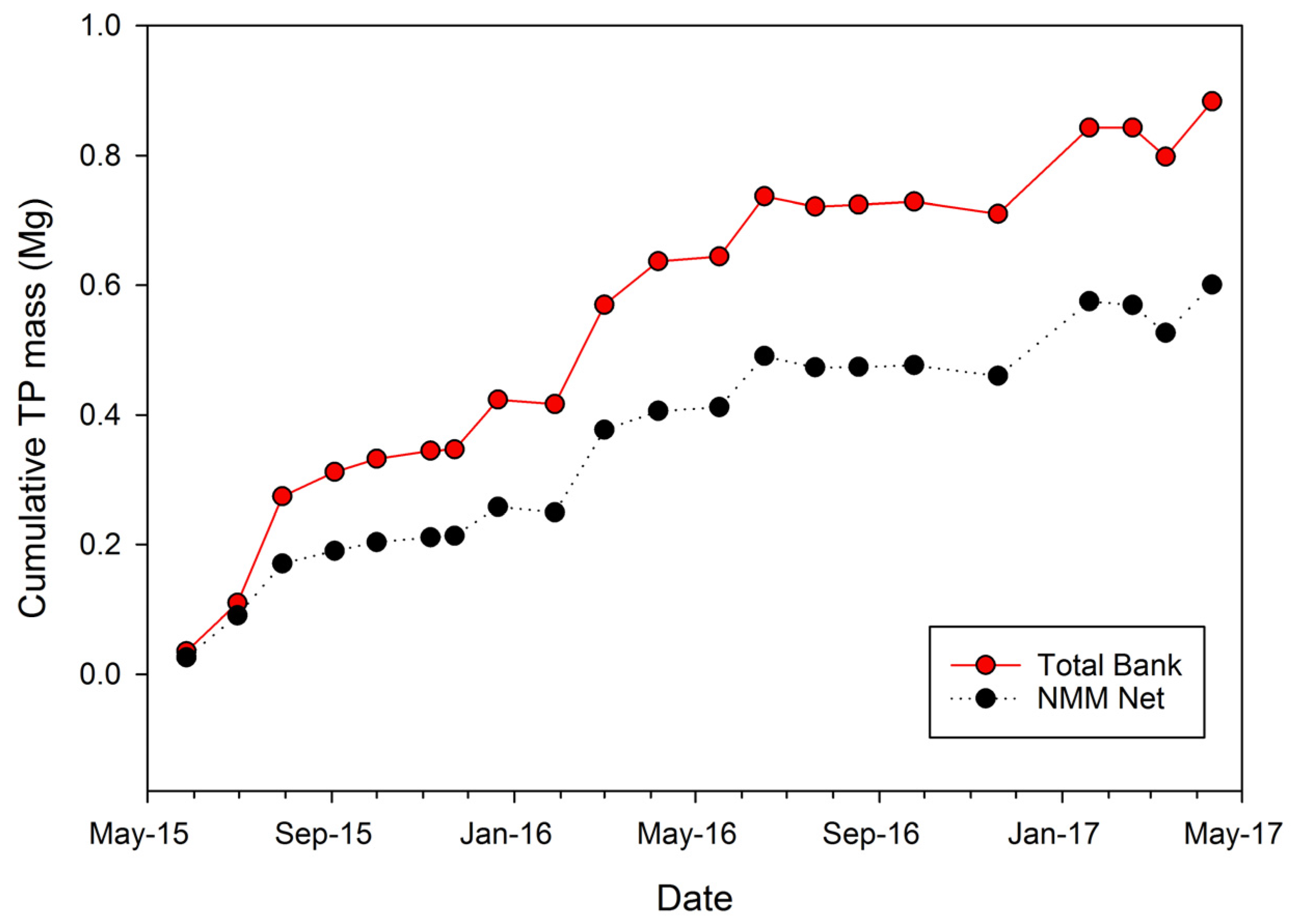
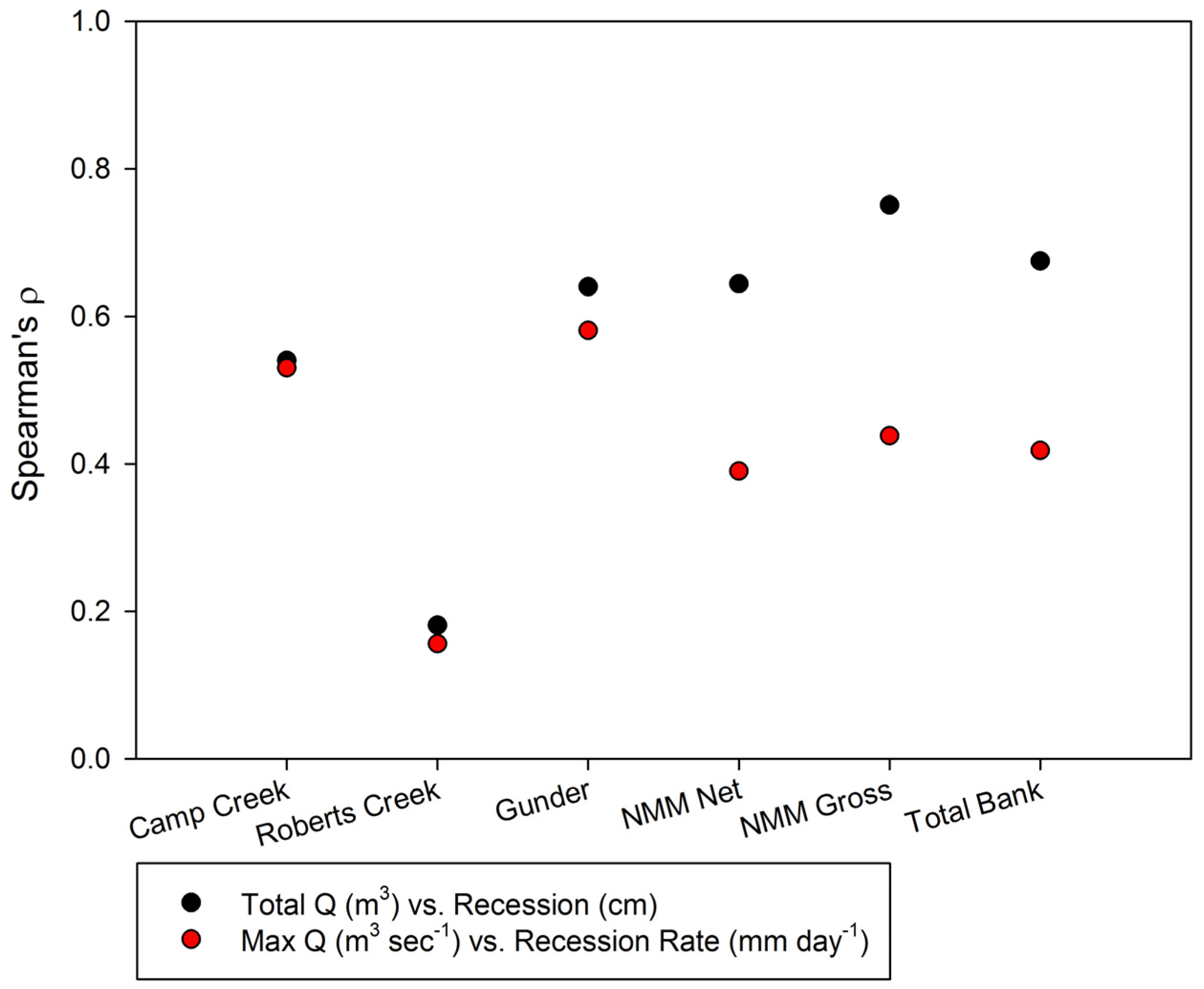
| Scenario | Material Present at Previous Measurement | Material Present at Current Measurement | Assign |
|---|---|---|---|
| 1 | NMM | NMM | NMM |
| 2 | NMM | Unit | NMM |
| 3 | Unit | NMM | NMM |
| 4 | Unit | Unit | Unit |
| Period | Duration (Days) | Total Precipitation (mm) | Annual Mean Daily Discharge (m3 s−1) | Maximum Mean Daily Discharge (m3 s−1) | Total Discharge (m3) | Main Stem Eroding Length (%) 1 |
|---|---|---|---|---|---|---|
| Year 1 (May 2015–April 2016) | 358 | 1118 | 0.71 | 11.28 | 22,099,904 | 25.1 |
| Year 2 (May 2016–April 2017) | 371 | 977 | 0.43 | 5.43 | 13,667,103 | 16.1 |
| Alluvial Unit | TP (mg kg−1) | SC (%) | Bulk Density (g cm−3) | WSA >2 mm (%) | WSA >0.25 mm (%) |
|---|---|---|---|---|---|
| Camp Creek | 170.8 (12.8) | 94.0 (1.1) | 1.30 (0.04) | 11.3 (1.3) | 44.9 (2.6) |
| Roberts Creek | 197.9 (33.8) | 91.2 (2.0) | 1.27 (0.02) | 21.5 (4.0) | 68.7 (3.5) |
| Gunder | 304.2 (62.5) | 71.5 (7.1) | 1.60 (0.04) | 3.8 (0.7) | 15.5 (2.7) |
| NMM | 241.4 (10.4) | 80.9 (1.9) | 1.20 (0.02) | 12.2 (3.2) | 31.0 (3.6) |
| Alluvial Unit | Year 1 1 | Year 2 2 |
|---|---|---|
| Alluvial Unit | % SA | % SA |
| Camp Creek | 11.2 (2.4) a | 7.2 (1.2) a |
| Roberts Creek | 5.8 (2.4) ab | 3.2 (2.1) bc |
| Gunder | 3.6 (1.1) b | 2.5 (1.1) c |
| NMM | 79.4 (4.9) c | 87.1 (3.4) d |
| Total Bank Cumulative Recession | |||
|---|---|---|---|
| Time Period | Mean (cm) | Minimum (cm) | Maximum (cm) |
| Year 1 (May 2015–April 2016) | 12.3 (2.6) | 1.8 | 27.9 |
| Year 2 (May 2016–April 2017) | 6.3 (1.4) | 0.6 | 14.4 |
| Study Duration (May 2015–April 2017) | 18.6 (3.8) | 6.0 | 42.3 |
© 2018 by the authors. Licensee MDPI, Basel, Switzerland. This article is an open access article distributed under the terms and conditions of the Creative Commons Attribution (CC BY) license (http://creativecommons.org/licenses/by/4.0/).
Share and Cite
Beck, W.; Isenhart, T.; Moore, P.; Schilling, K.; Schultz, R.; Tomer, M. Streambank Alluvial Unit Contributions to Suspended Sediment and Total Phosphorus Loads, Walnut Creek, Iowa, USA. Water 2018, 10, 111. https://doi.org/10.3390/w10020111
Beck W, Isenhart T, Moore P, Schilling K, Schultz R, Tomer M. Streambank Alluvial Unit Contributions to Suspended Sediment and Total Phosphorus Loads, Walnut Creek, Iowa, USA. Water. 2018; 10(2):111. https://doi.org/10.3390/w10020111
Chicago/Turabian StyleBeck, William, Thomas Isenhart, Peter Moore, Keith Schilling, Richard Schultz, and Mark Tomer. 2018. "Streambank Alluvial Unit Contributions to Suspended Sediment and Total Phosphorus Loads, Walnut Creek, Iowa, USA" Water 10, no. 2: 111. https://doi.org/10.3390/w10020111




